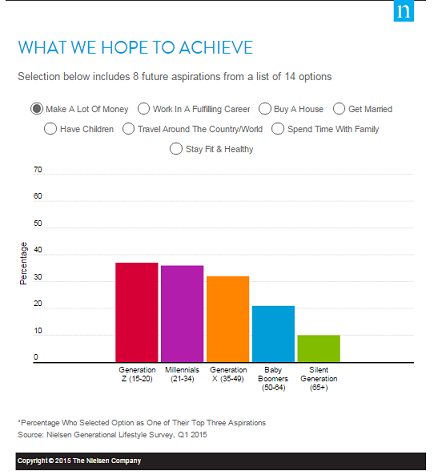 Many factors influence how we approach our daily lives, ranging from the income we earn to the values we hold dear. Our outlook on life is often shared with others who have similar traits—and age is no exception. But many of today’s consumers are bucking yesterday’s preconceived generational notions.
Many factors influence how we approach our daily lives, ranging from the income we earn to the values we hold dear. Our outlook on life is often shared with others who have similar traits—and age is no exception. But many of today’s consumers are bucking yesterday’s preconceived generational notions.
In fact, many older people are embracing a more technology-driven world, and sizeable numbers of younger people are turning to more traditional values. Yet for all our differences, in many ways, it’s remarkable how similar we are no matter the age.
The Nielsen Global Generational Lifestyles Survey polled 30,000 online respondents in 60 countries to better understand how global consumer sentiment differs across life stage. The findings break some myths and reaffirm others. For the purposes of this study, respondents are segmented into five life-stage classifications: Generation Z (age 15-20), Millennials (21-34), Generation X (35-49), Baby Boomers (50-64) and Silent Generation (65 and older). The results reveal insights about how consumers around the world live, eat, play and save.
In this first of a five-part series we focus on how consumers live—from preferred sources to get the news and ideal places to live to the aspirations we have for the future.
TV IS STILL TOPS FOR GETTING THE NEWS – EVEN AMONG MILLENNIALS
Global respondents may rely on a mix of traditional and digital sources to get up-to-date news, but the age skew on some sources is not what you may think. It’s probably no surprise that the majority of those over age 35 turn to TV to get the news, but the medium still holds sway for nearly half of Millennial (48%) and Generation Z (45%) respondents as well. Similarly, more Millennials prefer search engine sites than other generations, but they’re also among the top three news sources among respondents of all ages—even those 65+.
Looking beyond the sources that are universally preferred, the use of traditional sources to get the news is not surprisingly higher among older respondents, while younger generations are more reliant on digital ones.

TRADITIONAL VALUES ARE CHANGING, BUT NOT AS MUCH AS YOU MAY THINK
When it comes to the ideal place to live, big city/urban lifestyles have big appeal for younger respondents. More than half of Generation Z and Millennial respondents (52% and 54%, respectively) want to live in a big city or urban neighborhood. But young adults aren’t entirely shunning the suburbs in favor of metropolitan settings. More than one quarter of Generation Z and Millennial respondents think the suburbs are the best place to live. More Silent Generation respondents, on the other hand, prefer a life in the rural countryside.

SHIFTING PRIORITIES
Money may not buy happiness, but younger generations are willing to test that theory out. Over one-third of Generation Z (37%) and Millennial (36%) respondents say making money is a top goal for the future. And they aren’t just collecting paychecks. About three-in-10 also aspire to have fulfilling careers (31% of Generation Z and 28% of Millennials).
And while marriage and birth rates are declining in many countries around the world, not all younger respondents are opposed to these traditional aspirations. Buying a home, getting married and having children remain important goals for many young adults. In fact, about one-fifth of Generation Z and Millennial respondents consider buying a house (21% and 22% respectively), and about 10% (11% and 13%, respectively) consider having a baby as one of their top three aspirations for the future. Silent Generation respondents, on the other hand, have likely already achieved many of these goals, and show a higher preference for staying fit & healthy (71%), spending time with their families (50%) and traveling (36%).

Other findings from the recent report include:
Older respondents show higher levels of being distracted by technology at mealtime than younger generations.
Reading was selected as a top spare-time activity among Generation Z – higher even than playing video games or reviewing social media.
Millennials are roughly two times more likely than Generation X to leave their current job after two years.
Six-in-10 Millennials say they eat out at least once a week, twice the percentage of Baby Boomers surveyed.
Approximately half of younger respondents say they save money each month, but they aren’t confident in their financial futures.

